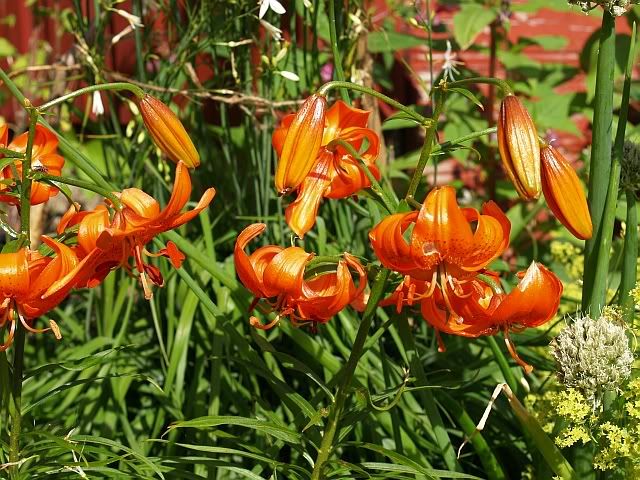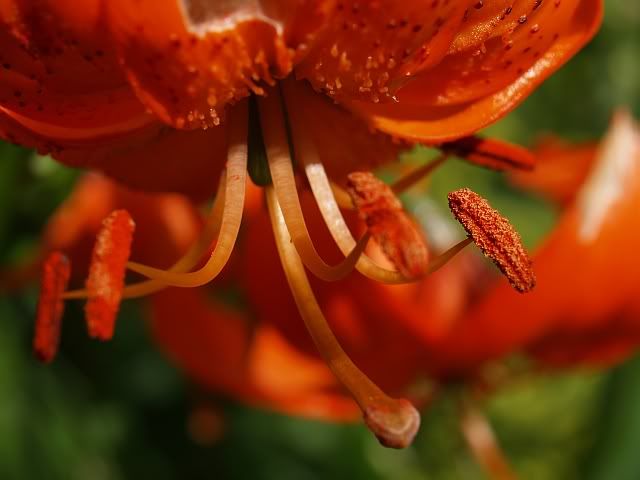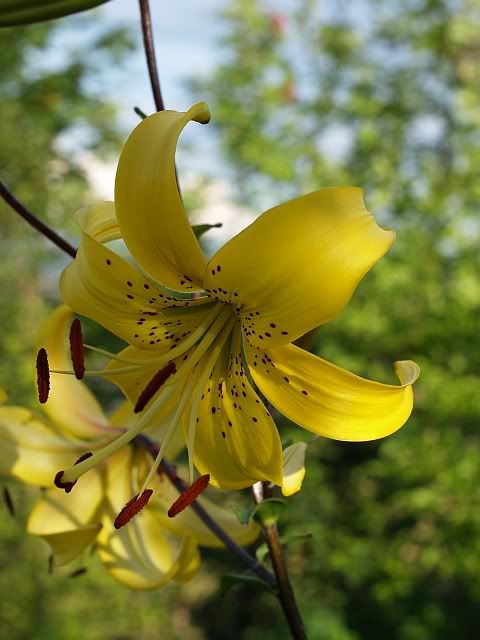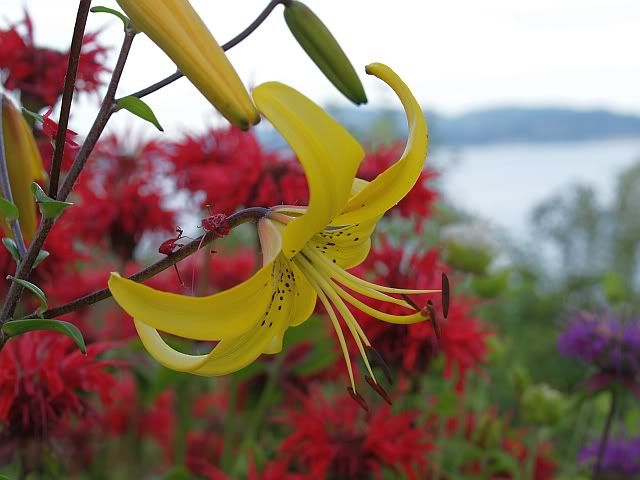|
|
Post by stevil on Feb 8, 2010 4:10:29 GMT -5
Sorry to spoil the fun a bit, but I've recently been studying the facts concerning reports of Dayliliies causing gastrointestinal distress. Yes, they can make you ill! I remember when I first got some Daylily starters by trading, the person who sent me them told me the following “Only the other week I ate a lot of them raw and it had a devastating effect on my digestive system an hour later”. I have seen numerous similar reports of people contracting poisoning symptoms, particularly when eating large amounts of fresh daylilies (e.g., Peter Gail reports various episodes in the US in his booklet “The Delightful Delicious Daylily”). The cause seems to be that Daylilies contain the alkaloid, colchicine.
Some people, myself included, do get an almost immediate burning sensation in the throat after eating Daylilies.
For these reasons, I rarely use them raw these days, although I don't think a few petals in a salad will hurt anyone (unless you are allergic). I also understand that the dried Daylilies are safe and anyway they are always cooked well, which also apparently destroys the colchicine (it is water soluble).
Thanks to Google Translate, I've also learnt that the Chinese authorities regularly put out public health warnings against eating raw Daylilies, so it's obviously a problem.
Therefore, I would advise you not to eat large quantities of raw Daylilies and it may also be wise, if you want to use a lot of Daylilies, to concentrate on the Hemerocallis species used for millennia in China rather than the myriad of garden varieties of which we know very little as far as chemical composition is concerned (although again a few flowers in a salad should not have any effect).
I hope this doesn't put you off and I still rate them very high as edimentals.
|
|
|
|
Post by ottawagardener on Feb 8, 2010 8:59:20 GMT -5
Darn, but good to know. Is this alkaloid then altered when cooked? I know I should just google this question and will  Thanks |
|
|
|
Daylily
Feb 8, 2010 11:45:42 GMT -5
Post by ceara on Feb 8, 2010 11:45:42 GMT -5
Edimentals. I love that word!!
There is also a bulb Lilium from China that can be cooked/eaten like potatoes. I forget which one it is. Maybe L. tigrinum? Would have to check on that.
|
|
|
|
Daylily
Feb 8, 2010 14:41:09 GMT -5
Post by stevil on Feb 8, 2010 14:41:09 GMT -5
Edimentals. I love that word!! There is also a bulb Lilium from China that can be cooked/eaten like potatoes. I forget which one it is. Maybe L. tigrinum? Would have to check on that. Tigrinum is one of many used in the east. This reminds me of a work trip I was on some years ago. I stopped off in Singapore and bought the following packet of Edible Lily bulbs in the supermarket by the hotel:  I ate some (quite a sweet taste) and planted the rest in my garden and they've proved perfectly hardy. According to experts on the Scottish Rock Garden Forum, this is Lilium davidii willmottiae.   Yes, another edimental, one of the best... It's widely cultivated in China. |
|
|
|
Daylily
Feb 8, 2010 15:33:39 GMT -5
Post by ottawagardener on Feb 8, 2010 15:33:39 GMT -5
Nice and great picture, especially the detail short at the bottom.
|
|
|
|
Daylily
Feb 8, 2010 15:55:16 GMT -5
Post by ceara on Feb 8, 2010 15:55:16 GMT -5
Do they make stem bulbils?
Awesome photos!
|
|
|
|
Daylily
Feb 8, 2010 16:59:04 GMT -5
Post by stevil on Feb 8, 2010 16:59:04 GMT -5
No, no bulbils unfortunately, unlike tigrinum...and I don't think it's produced seed either - have to propagate by bulb scales.
|
|
|
|
Daylily
Feb 9, 2010 13:02:08 GMT -5
Post by ottawagardener on Feb 9, 2010 13:02:08 GMT -5
How long do they take from scale to useable bulb?
|
|
|
|
Daylily
Feb 9, 2010 14:18:05 GMT -5
Post by ceara on Feb 9, 2010 14:18:05 GMT -5
In my experience with Asiatic Lilies, approx 3 years to blooming size. And first year bloom, you get 1 flower. 2nd year, 3 flowers. 3rd year 5-7. After that, some lilies can get up to 15 blooms per bulb and some bulbs can get massive, up to several pounds in weight. But with the Martagons and stem bulbil-producing Tiger types, no idea since I don't have any of those. Martagons are picky buggers and sulk when planted and may not even be seen for a couple of years after planting. But Asiatic, Oriental, Trumpets and all their hybrids are not that fussy and surprisingly hardy.
Lilies are easy to clone via bulb scale. You can snap off a few scales (which doesn't hurt the bulb as long as you don't remove too many) and replant near the parent, or put them into slightly damp peat moss in a sandwich bag, or push them basal plate down in some potting mixture and cover with plastic to keep moisture in. Any scale popped off needs it's part of the basal plate to work. Each scale can potentially produce up to 7 or more baby bulbs, so when some babies are getting big, pop them off and put the scale back in the bag.
I believe this is their natural recovery method should the bulb be dug up and destroyed by critters. Any bit left over with basal plate will regrow. I've even seen bulbs sliced in half with a spade recover in two seasons.
I'm still looking for L. canadense if anyone has those growing wild near your homes. They are really pretty.
|
|
|
|
Daylily
Feb 9, 2010 15:50:02 GMT -5
Post by stevil on Feb 9, 2010 15:50:02 GMT -5
I was going to say about 3 years too. However, the lily in the picture - Lilium tigrinum flaviflorum (Yellow Tiger Lily) flowered in just two years starting from bulbils - sorry, it either didn't produce bulbils this year or I forgot to collect them. I didn't check the bulbs for size unfortunately.  The red in the background in the next picture is a red-flowered Monarda.  |
|
|
|
Daylily
Feb 9, 2010 15:55:04 GMT -5
Post by stevil on Feb 9, 2010 15:55:04 GMT -5
I sowed Lilium canadense again earlier in the winter - no seed left over I'm afraid. Last time I think i grew it on too dry woodland soil - I've learned since that it is a wetland Lily. Is that correct?
|
|
|
|
Daylily
Feb 9, 2010 16:25:26 GMT -5
Post by ceara on Feb 9, 2010 16:25:26 GMT -5
|
|
|
|
Daylily
Feb 23, 2010 9:42:38 GMT -5
Post by JanetM on Feb 23, 2010 9:42:38 GMT -5
Hi! Just seen this thread. Since I am just starting out I was wondering. Do any of these day lillys bloom all summer, bloom at different times of the year, and do well in semi-shade? I live in a woods with some semi-shade around the house and could really use more color. I don't have any seeds yet to trade, since I am a new member, but be happy to cover cost of shipping/mailing any seed/bulbs to me. Thanks Janet
|
|
|
|
Daylily
Feb 23, 2010 10:14:34 GMT -5
Post by plantsnobin on Feb 23, 2010 10:14:34 GMT -5
Janet, the plants in Stevils photos above aren't dayliles, but some of the types he shows do grow well in part shade. Dayliles, bloom mostly late June to July around here, and I have tons that I need to find a new home for. Each bloom will last only a day, but there are several blooms per plant. They can be planted just about any time the ground isn't frozen-they are just about impossible to kill. Most of mine are in shades of purple to pink, I don't do orange. You are welcome to a bunch-like at least 100 ft row of them. Interested? I'll start digging them if you are.
|
|
|
|
Daylily
Feb 24, 2010 9:36:23 GMT -5
Post by JanetM on Feb 24, 2010 9:36:23 GMT -5
Karen, they are not Daylilys? I'm sorry, I thought you were talking about Daylilys. We have a few around here and they look like that only different colors. So they are a different type of lily, not daylilys but still a lily? Well, I am puzzled. Do these bloom for more than a day?
|
|









 I have never had good luck with Lilium seeds. Most of mine just produce chaff and no embryos. *shrugs*
I have never had good luck with Lilium seeds. Most of mine just produce chaff and no embryos. *shrugs*